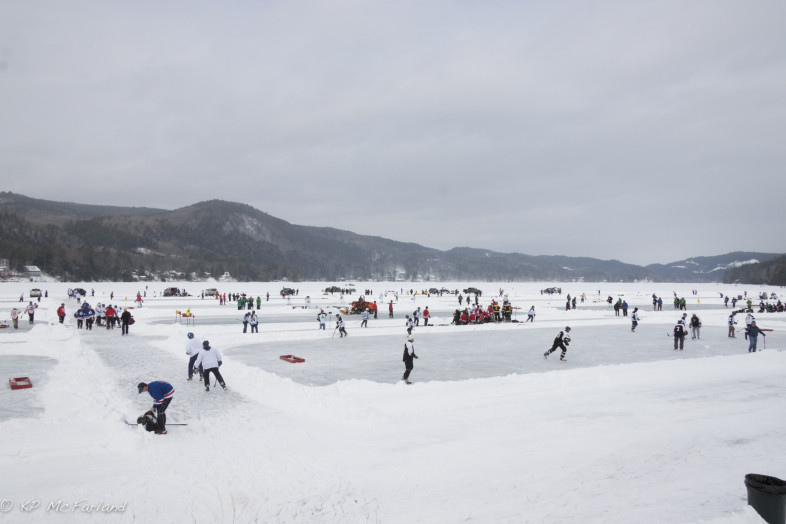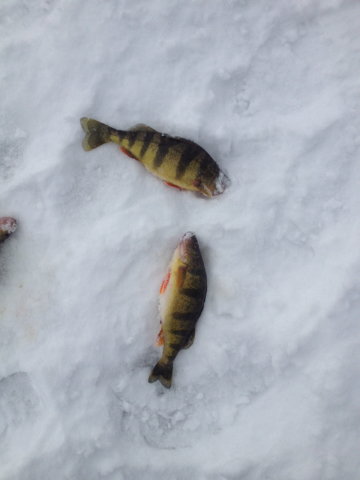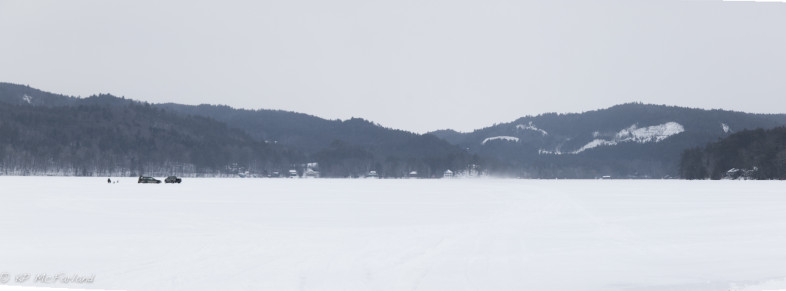
A pond hockey takes place on Lake Morey ice while VCE biologists talked about life in the cold below. / © K.P. McFarland
Nordic skating, pond hockey, small planes landing and ice fishing – there’s a lot happening on Lake Morey’s ice.This month on Outdoor Radio, VCE biologists Sara Zahendra and Kent McFarland skate out and talked about life in the cold water below with some ice fisherman far out on the lake.
Listen
Biologists Kent McFarland and Sara Zahendra glide out on to the ice covering Lake Morey in Fairlee.
“It’s February in Vermont and it’s pond hockey time,” says McFarland.
“We’re standing on Lake Morey, it’s a beautiful day and it’s just started to snow a little bit,” Zahendra adds.
Around 20 hockey teams are on the lake for a tournament, and towards the middle of the lake there are several ice fisherman. McFarland and Zahendra skate over to them.
“Tell us what kind of fish those are,” says McFarland.
They’re perch, and the fishermen have caught quite a few. They drop their line to the bottom of the lake using weights, where the water is the warmest.
“Well, comparatively warm,” Zahendra says. “It’s roughly 39 degrees down there at the bottom … in a lot of temperate lakes and ponds in this area, they’ll undergo something called inverse stratification.”
What is inverse stratification? She explains that water is most dense at 39 degrees Fahrenheit and as it cools or warms, it becomes less dense. “When it gets down to 39 degrees, it’s going to sink down to the bottom of the lake and that’s going to happen over and over again … until, at some point, almost all the lake is going to be roughly 39 degrees Fahrenheit,” she says. Then, once the temperature drops to 32 degrees, the water freezes and floats to the top because it is less dense than the rest of the water in the lake.
“Which is why we aren’t skating at the bottom of Lake Morey,” jokes Zahendra.
McFarland adds, “And this is why those fish are at the bottom and [the fisherman] are using weights to get to them.” He also explains that the fish are moving slowly this time of year. “In the summertime, when they feed, it’s something like 24 hours for them to digest their meal. Now, when it’s this cold, if they had a meal today, it could take them seven days – a week – do digest their food,” he says.
The lake also undergoes a loss of oxygen during the winter months. “As soon as this layer of ice covers this whole lake, the lake is cut off from oxygen. So whatever amount of oxygen was in the lake when that ice covered the lake, that’s basically going to be the amount of oxygen that’s going to be in the lake until the spring thaw,” says Zahendra. But, she adds, fish breathing and decomposition take up oxygen, so the farther into the winter, the less oxygen there is in the water.
Another big change underneath the ice is the plant life. “In the summertime when you swim here, there are plants all over the place and you swim through them. It’s a forest of plants underneath,” says McFarland. But as soon as the ice freezes, and there is a build up of snow on top, it gets very dark underneath. “And just like the deciduous forest around us, they lose their leaves and they die back … when this snow melts and this ice breaks up and the sunlight starts penetrating, just like the forest leafing out and flourishing, all the vegetation at the bottom of the lake is going to do the same thing,” he says.
“As soon as this layer of ice covers this whole lake, the lake is cut off from oxygen. So whatever amount of oxygen was in the lake when that ice covered the lake, that’s basically going to be the amount of oxygen that’s going to be in the lake until the spring thaw.” – Sarah Zahendra, biologist
And as the vegetation starts to come alive in the spring, the rest of the lake does the same thing. “The fish become more active, the turtles become more active … everything starts moving like we’re used to seeing when we swim around this water in the summertime,” Zahendra says.
“So there are a lot of similarities between what’s going on underneath the ice and what’s going on top here too,” says McFarland, as they skate back towards the hockey tournament.
More Resources:
- As the global climate shifts towards a warmer state, the cold season in Vermont is getting shorter and the warm season longer. Check out these charts showing how ice-out on Vermont ponds and lakes has been getting earlier and earlier.
- Winter Activities on Lake Morey
- Vermont Ice Fishing Opportunities
Outdoor Radio is produced and edited by Chief Production Engineer, Chris Albertine, at Vermont Public Radio.



Nice interaction and background pond frolic sounds, and I love learning about the 39 degree phenom, and who knew there was decent perch fishing on Lake Morey? Ted